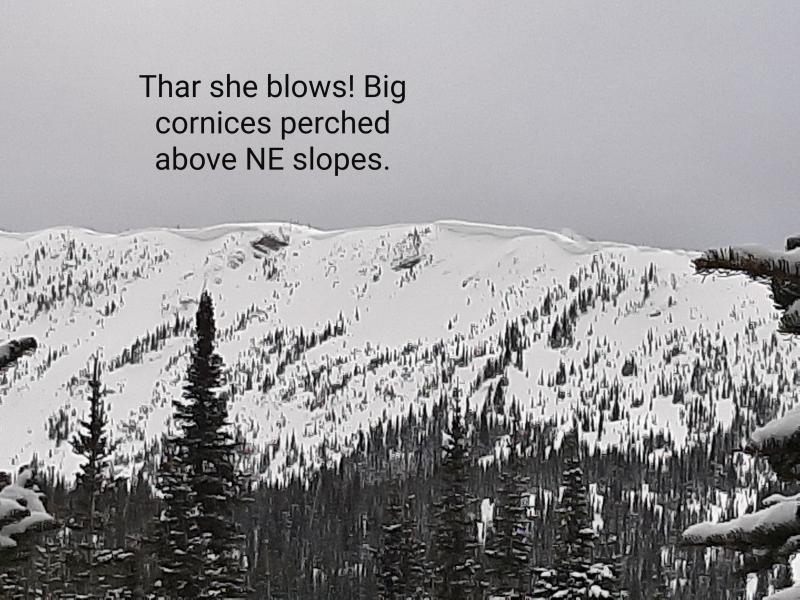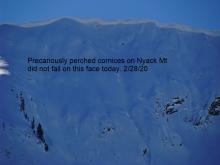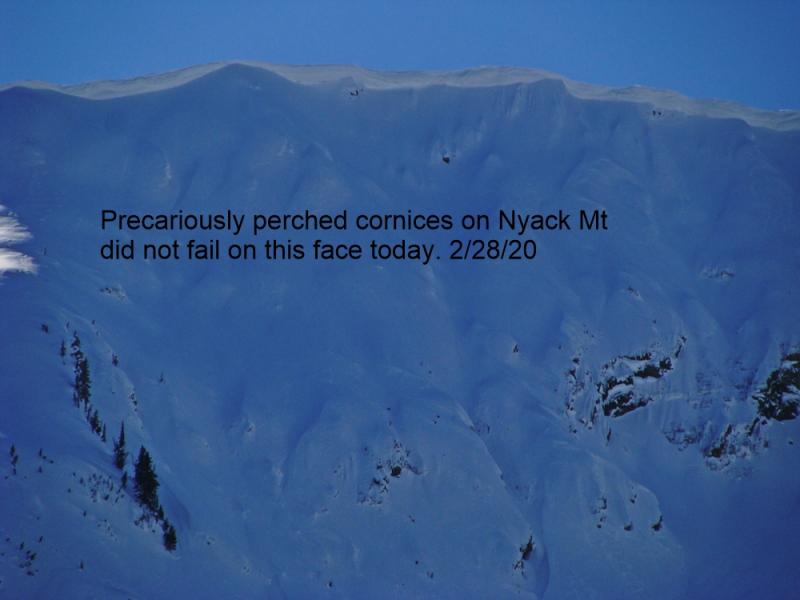| Saturday | Saturday Night | Sunday | |
|---|---|---|---|
| Cloud Cover: | Diminishing showers and clearing with building high pressure. | Partly cloudy. | Return to showers in the afternoon. |
| Temperatures: | 34-45 deg. F. | 21-27 deg. F. | 33-46 deg. F. |
| Wind Direction: | W-SW | S-SW | S-SW |
| Wind Speed: | 7-10 gusts 22 | 6-7 gusts 18 | 8-12 gusts 18-28 |
| Snowfall: | 0 in. | 0 in. | 0-3 in. |
| Snow Line: |
Whitefish Range
Swan Range
Flathead Range and Glacier National Park
How to read the forecast
Today should be a repeat of last weekend with another sharp transition from winter to spring conditions. Warming temperatures and sun expected today will weaken the surface of nearly 2 feet of recent snow, and increase the likelihood of loose, wet avalanches. The avalanche danger will rise to CONSIDERABLE on sunny slopes above 5000 feet today. In other terrain the danger is MODERATE. Carefully evaluate recently formed wind slabs for lingering instability and give large cornices a wide buffer.

3. Considerable
?
Above 6500 ft.
3. Considerable
?
5000-6500 ft.
2. Moderate
?
3500-5000 ft.
- 1. Low
- 2. Moderate
- 3. Considerable
- 4. High
- 5. Extreme
-
Type ?
-
Aspect/Elevation ?

-
Likelihood ?CertainVery LikelyLikelyPossible
 Unlikely
Unlikely -
Size ?HistoricVery LargeLargeSmall

Yesterday it took very little time for the warming and sun to affect the surface of the abundant recent snow. We began to see small roller balls, and even a few small loose, wet avalanches with only about 30 minutes of sun exposure. Today, with more sun and slightly warmer temperatures expected, we should see loose, wet slides involving a lot more snow. This problem is easily managed by moving off and out from under sunny slopes when the snow surface becomes moist. Even though this is a manageable problem, these avalanches can move fast, entrain a lot of snow, and try to pull you down the hill with them. At lower elevations where there is less recent snow, consider the terrain you are traveling in and the amplified effect of small avalanches by terrain traps like trees, cliffs, and narrow gullies.
-
Type ?
-
Aspect/Elevation ?
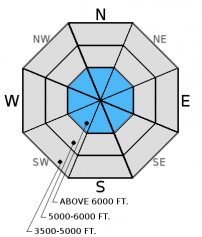
-
Likelihood ?CertainVery LikelyLikelyPossible
 Unlikely
Unlikely -
Size ?HistoricVery LargeLargeSmall

Wind slabs can take up to a week to gain strength. Erich found sensitive wind slabs on Thursday, and yesterday we observed continued drifting of the recent snow. On sunny aspects many of these slabs formed on a crust that will provide a good sliding surface. Look for rounded pillows of wind drifted snow along leeward ridgelines and cross loaded mid-slope features especially on convex rollovers. Pay attention for obvious signs of instability like recent avalanches and cracks shooting out from your skis or machine.
-
Type ?
-
Aspect/Elevation ?
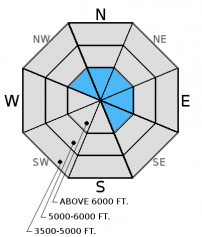
-
Likelihood ?CertainVery LikelyLikelyPossible
 Unlikely
Unlikely -
Size ?HistoricVery LargeLargeSmall

Recent strong winds added to the mass of already large cornices across the advisory area. These massive cornices can pull out from surprising distances behind the ridgeline. Though you should always remain a safe distance behind cornices when traveling above them, they will be more susceptible to failure with prolonged periods of sunshine. It is also important to minimize exposure to cornices when traveling below them. The large amount of stress a falling cornice puts on the snowpack can trigger deeper weak layers like wind slabs or weak snow near the late Feb. or March crusts.
Additional concern: Weak snow surrounds a series of crusts 1.5 to 3 feet from the surface, but has not produced recent avalanches. However, digging into the snow and performing stability tests is the only way to determine if this weak layer exists. Stability tests in some locations including yesterday in the Swan Range show these layers can fracture and propagate (video1, video2).
As we continue into spring we have observed glide cracks starting to open in many locations and several have even failed (image). Given the unpredictable nature of glide avalanches it is best to avoid slopes where they are present.
Friday: Erich and I rode into the Lost Johnny drainage in the Swan Range. We found 14-22 inches of recent snow on top of a crust. We observed fresh windslabs formed on the leeward sides of ridges, and moderate winds continued to drift the recent snow (observation).
Thursday: Erich toured along the Marion Lake/Dickey Creek ridgeline yesterday in the Flathead Range. They observed shooting cracks on most wind loaded terrain and triggered a 100 ft. wide and 10-14 inch deep wind slab on a northeast aspect (image and video). Strong winds were loading multiple aspects (observation). Deeper weak layers around a series of crusts were unreactive in our stability tests at this location.
Tuesday: Mark, along with a Glacier NP ranger, visited Peak 6996 in southern Glacier Park to follow up on the avalanche incident from last Friday. A snowboarder triggered an 18 inch thick wind slab. The fracture propagated up to the cornice which then failed onto the slope. This slab sat on top of a thin layer of facets which capped a recent rain crust. There was also a surface melt freeze crust that formed Sunday extending from the valley floor to the summit (observation).
Monday: Mark observed glide cracks on south facing terrain in Canyon Creek in the southern Whitefish Range, and easily initiated pinwheels, rollerballs, and small wet loose avalanches on top of a rain crust (observation).
Visit our Observations page and our You Tube channel for more observations from the entire season.
Thanks to everyone for submitting observations. They are extremely useful and could help save lives.
HOW TO SUBMIT OBSERVATIONS:
Email: [email protected]
Call and leave a message: 406.387.3821
You can also submit quick observations via text: 406.241.4571 (FAC mobile)
OR
Submit Snowpack Observations: http://www.flatheadavalanche.org/node/add/snowobs
Submit Avalanche Observations: http://www.flatheadavalanche.org/node/add/avyobs
Yesterday several bands of precipitation brought 2-3 inches of new snow to the area before diminishing in the early afternoon. Over the past 72 hours the area saw 15-22 inches of snow. Winds were moderate out of the southwest and briefly shifted to the north and northeast. Currently, mountain temperatures range from 22º-28º F, and winds are out of the southwest at 5-15 mph with gusts from 11-22 mph. Today a ridge of high pressure is expected to move into the region and bring slightly warmer temperatures and partial clearing. Temperatures should climb to the mid-upper 30s, and winds will continue out of the southwest at 5-15 mph.
| 0600 temperature: | 22-28 deg. F. |
| Max. temperature in the last 24 hours: | 32-40 deg. F. |
| Average wind direction during the last 24 hours: | SW |
| Average wind speed during the last 24 hours: | 5-10 mph |
| Maximum wind gust in the last 24 hours: | 11-22 mph |
| New snowfall in the last 24 hours: | 2-3 inches |
| Total snow depth: | 88-115 inches |
This advisory applies only to backcountry areas outside established ski area boundaries. This advisory describes general avalanche conditions and local variations always occur. This advisory expires at midnight on the posted day unless otherwise noted. The information in this advisory is provided by the USDA Forest Service who is solely responsible for its content.
























